Does TDCS Really Work: A Case Study
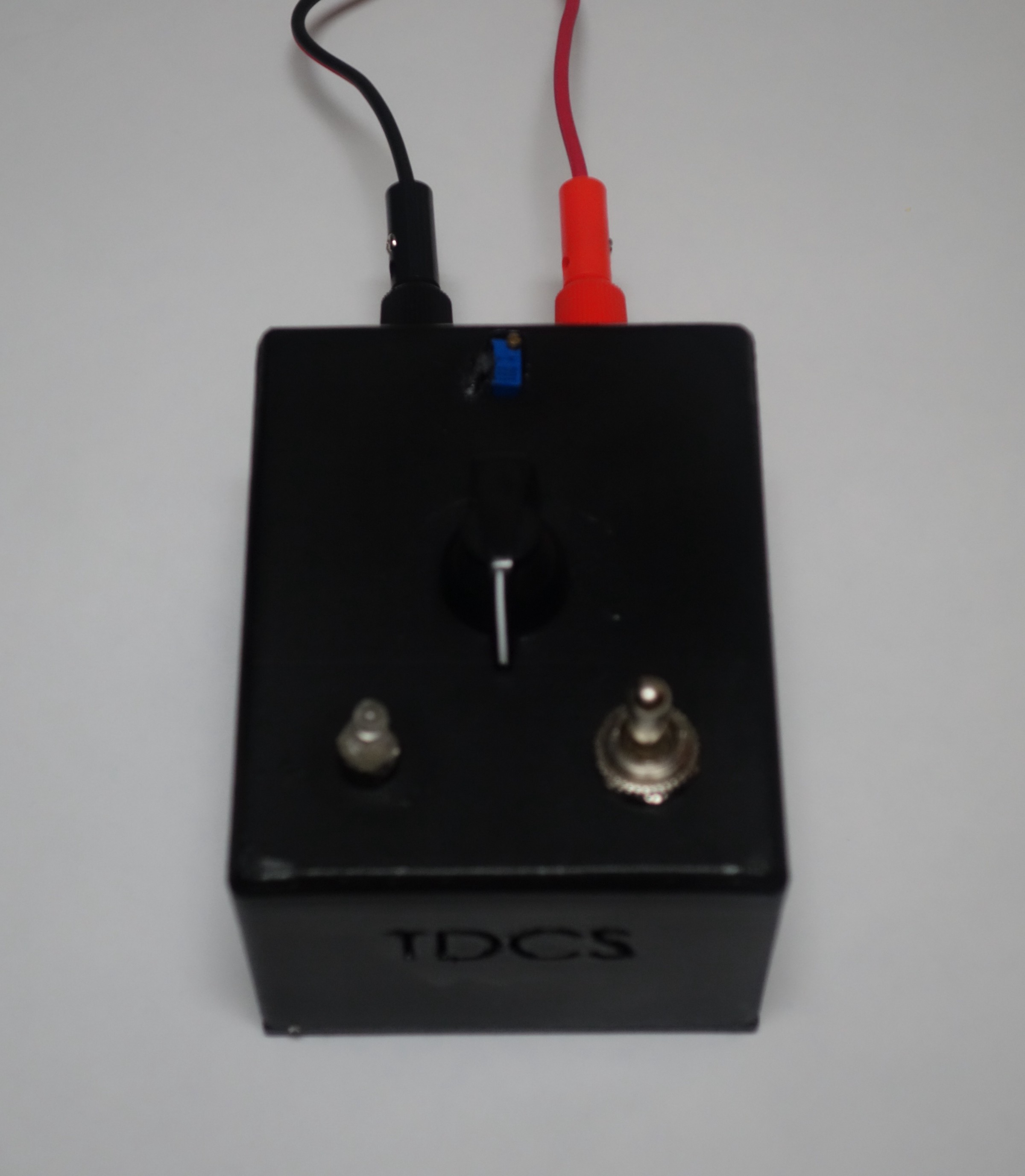
The TDCS device — fully assembled
In my previous article I explained exactly how I created my own Transcranial Direct Current Stimulation Device from scratch. However, I didn’t just want to make my own device to see if it worked on my, I wanted to see if it made any difference in general. Thus, I created a study to study the effectiveness of my TDCS device.
NOTE: this study was done with permission from all participants and should not be replicated without proper approval and medical supervision
Introduction
Transcranial Direct Current Stimulation (TDCS) is a form of neurostimulation that will deliver a constant current to a persons brain over a specified amount of time. In the medical world it has been found to have a wide variety of uses, such as decreasing pain, treating depression, and even aiding with the healing of brain injuries. However, recent studies have shown that TDCS has the ability to enhance cognitive ability in heathy people.
The explanation behind how TDCS works is shown through the neurons present in the human brain. These neurons communicate using small electrical pulses, called synapses, to relay information. Stimulating certain parts of the brain with so-called “electrical synapses”, can conduct nerve impulses faster, which allows information to pass from neuron to neuron more quickly. The current induces intracerebral current flow to increase or decrease neuronal excitability.
Purpose
In a world driven by intelligence and innovation, it can often seem hard to improve our mental capacity to master all of the mental demands that are placed on us daily. Recently, research in the world of neurostimulation has shown this it is possible to change certain aspects of the human brain through transcranial direct current stimulation. I set out to see if the human psyche can actually be altered through low current stimulation, and if so, how much of a difference it might make in a real world environment. Thus, I set up an experiment to determine the effects of neurostimulation on human motor control.
Methods and Materials
The first step in the process of this experiment involved creating the TDCS device. Once the components were assembled to ensure they were functioning properly. Then they were soldered inside of a 3D printed box for portability. The electrodes were made using aluminum mesh, sponge cloth, and an elastic band.
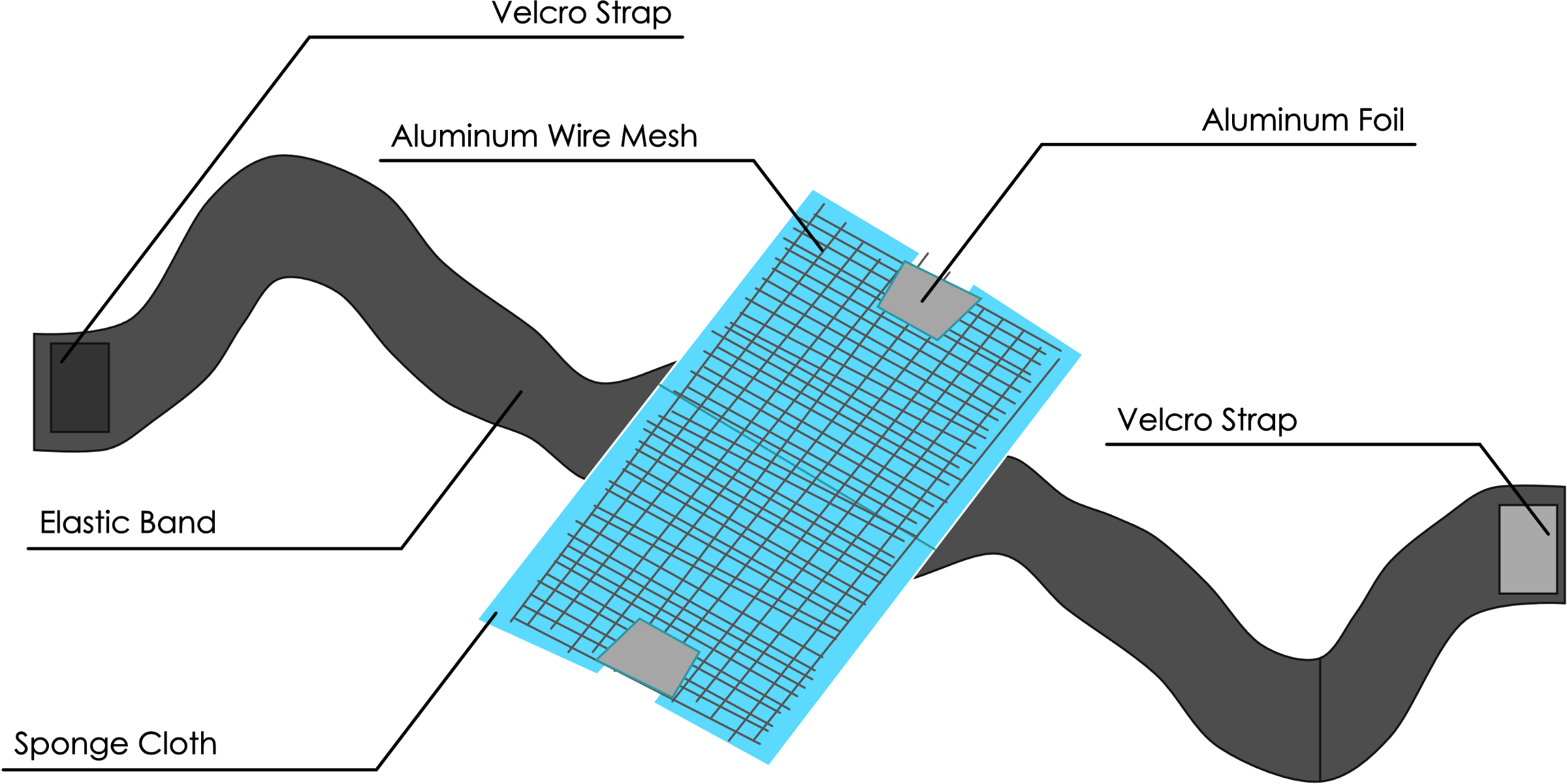
Graphical representation of the electrodes
To ensure the TDCS was making a difference in the user, I devised an experiment to show if it had any effect. I had three groups play the same video game twice. The first group would play the game, wait twenty minutes, and then play the game again. The second group would play the game, receive 15 minutes of TDCS treatment, and then play the game again. The third group would play the game, be told they were receiving 15 minutes of TDCS treatment, although no treatment would take place.
These three separate groups ensured that it would be able to be seen if the increase in score was simply a result of practice, or other factors.

A participant taking part in the study
Methods (Detailed)
Step 1 — Prepare the saline solution for use
The ratio that I used for the saline solution was 1 teaspoon of salt for every cup of water. The solution would then be stirred until all of the grains of salt were dissolved.
Step 2 — Properly saturate the sponge electrodes
Using a plastic pipet, the saline solution was transferred to both sides of the sponge until they were moist, but not dripping wet.
Step 3 — Administer benchmark test
The testing for this experiment was done using the shooting mini-game on the Wii Play game. The game was chosen because it required quick, deft hand movements, and fast reaction times. A chair was placed ten feet away from the television and Wii sensor bar, and the subject was seated in the chair facing the television. The subject was then given the game remote, told the instructions of the game, and then told to do their best.
Step 4 — Record benchmark score
All the ‘before’ scores were recorded on a journal that I used while administering the trial.
Step 5 — Prep hair for electrodes
For subjects with hair on the top of their head, saline solution was used to wet the area obstructed by the hair to ensure conductivity to the scalp.
Step 6 — Place electrodes on head
The electrodes were placed in accordance with the Enhancing Motor Ability - Reducing Pain montage, but mirrored from their original position. The cathode was placed on the frontal polar lobe (FP2) position, which is generally above the right eyebrow. The anode was placed on the central cortex (C4) postion, which is generally the uppermost right point of the head. The electrodes were secured using the elastic headbands.
Step 7 — Connect alligator clips to electrodes
Once the electrodes were positioned on the head of the subject, the alligator clips connected to the banana jacks were secured on the electrodes.
Step 8 — Place headphones on the subject
Unconnected headphones were placed on the subject to help minimize external sound.
Step 9 — Turn on the TDCS device
The TDCS device was turned on and the current was slowly increased over the course of a minute until it reached the maximum of 2mA.
Step 10 — Record observations
Over the course of the fifteen-minute trial, the subject was asked three times how they felt and if they had experienced any changes. Any comments were noted in the notebook.
Step 11 — Turn off the TDCS device
At the end of the 15-minute period, the device was slowly turned all the way down and then switched off.
Step 12 — Remove headphones and electrodes
All of the apparatus’ on the subject’s head were removed, and the electrodes were rinsed to remove saline solution to prevent a NaCl buildup.
Step 13 — Re-administer the benchmark test
After everything was removed the subject was reminded of the rules of the game, and played it again.
Step 14 — Record final scores and observations
After the subject completed the second game, their score was recorded and they were asked if they had felt any different in the second round of the game.
Step 15 — Clean up and dismiss subject
Thus marks the end of the experimentation.
Results
Control Group

The scores collected from the control group showed that there was an average score increase of 20.988%
Authentic Group

The scores collected from the group who actually had current flowing in their head showed that there was an average score increase of 23.806%
Placebo Group

The scores collected from the group who received a placebo test showed that there was an average score increase of 7.306%
In this test the electrodes were placed in accordance with the Enhancing Motor Ability - Reducing Pain montage, but mirrored from their original position. The cathode was placed on the frontal polar lobe (FP2) position, which is generally above the right eyebrow. The anode was placed on the central cortex (C4) position, which is generally the uppermost right point of the head. The electrodes were secured using the elastic headbands.
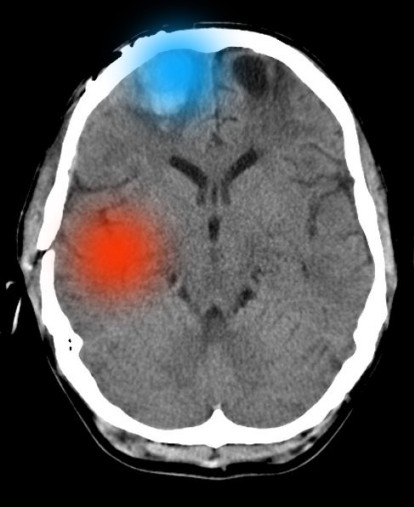
The locations of the anode (red) and cathode (blue)
The testing for this experiment was done using the shooting mini-game on the Wii Play game. The game was chosen because it required quick, deft hand movements, and fast reaction times. A chair was placed ten feet away from the television and Wii sensor bar, and the subject was seated in the chair facing the television. The subject was then given the game remote, told the instructions of the game, and then told to do their best.
Results from this test showed that when the subjects were actually treated using the TDCS device, their score increased at a higher percentage than both the control group and the placebo group. Furthermore, the actual test group had a lower percent deviation than the other two groups. The control group especially had a very high percent deviation, which suggests that those in the control group had very different results based on factors not in any way related to neurostimulation. Another curious aspect is that the placebo seemed to have the opposite effect than what was intended, as the percent change was even lower than the numbers found in the control group.
Average Percent Deviation
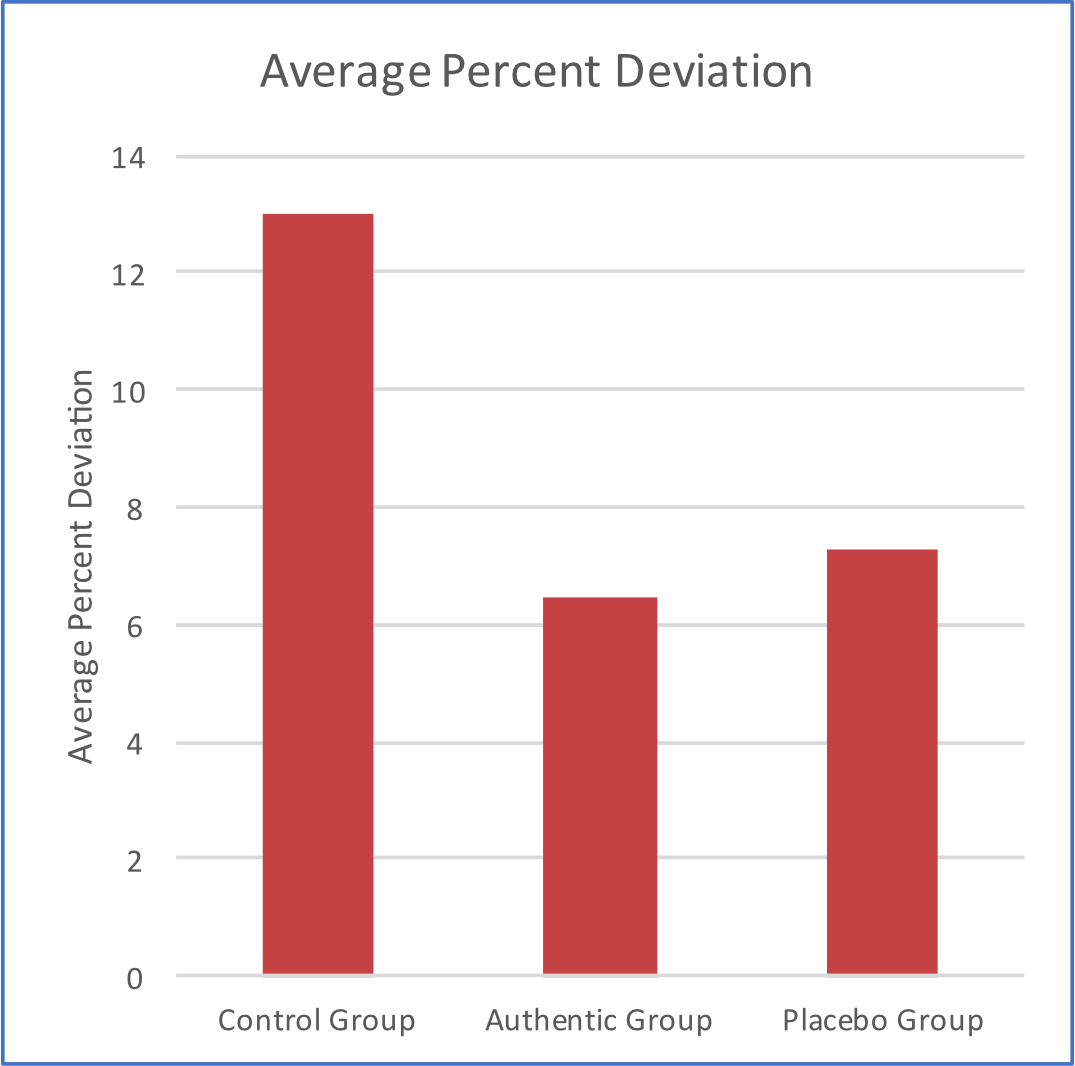
This graph shows that the control group had the highest percent deviation and the authentic had the lowest
Discussion

The Average Percent Increase of the study, showing that the actual participants had the highest increase when compared to the placebo and control group
The average increase in the control group was 20.988%, while the actual test group was only 2.818% higher. This likely occurred because simply allowing a person to play the game twice will give them practice and experience that will lead to an increased score. However, it can also be seen that the actual test scores occurred in a much narrower range than the control group. This suggests that with the TDCS device, the percent increase is much more consistent and predictable.
As seen in the data, the percent change in the placebo trials is noticeably lower than the control tests. Because no current was actually running through the subjects brain, the reason for this discrepancy must lie outside of the realm of neurostimulation. The most likely explanation comes from the headbands themselves. As in the regular test, the placebo subjects would don tight headbands that were soaked in water. It is possible that the pressure of the bands or the contact of the water to the skin led to an uncomfortable situation that was reflected in the percent change of the subjects. This is certainly seen in the observations, where patients regularly said they could feel the tightness of the bands on their head.
This understanding of the placebo test makes the 23.806% increase in the actual trial all the more significant. If indeed the headbands were in someway hindering the user, than that means that the TDCS made up for that discrepancy, as well as a little bit more. This is because as the current was applied to those specific areas of the brain, the synapses were stimulated more than usual, which increased in faster motor speed, and increased reaction time.
Future Implications
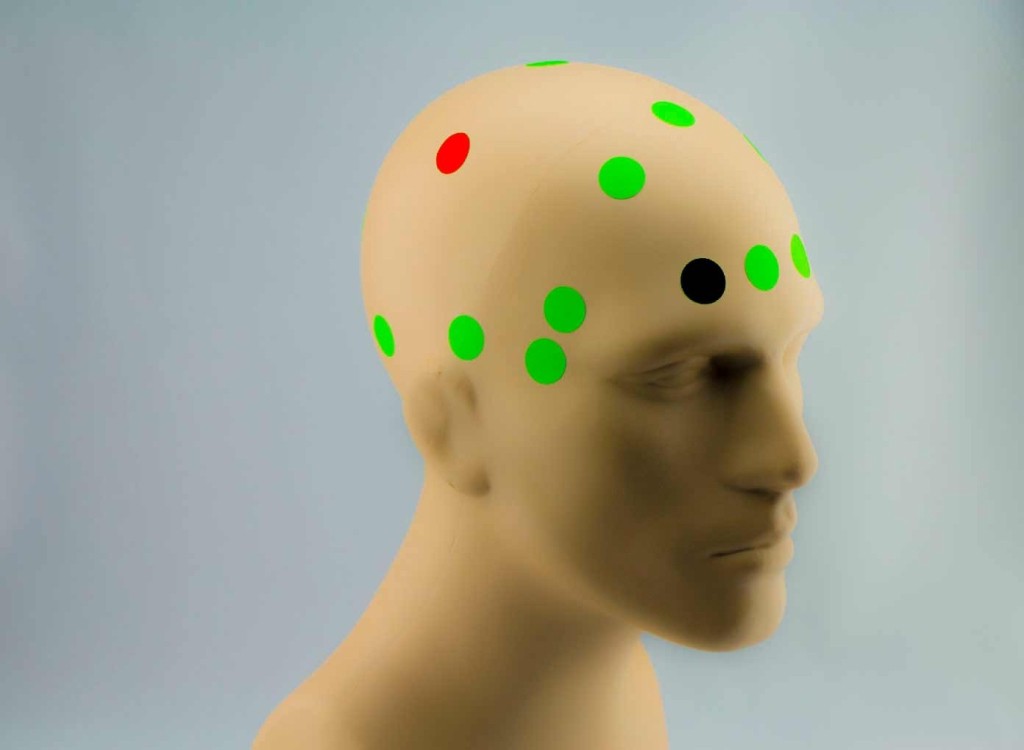
A diagram showing the different possible paces of TDCS electrodes on the head
In the past, transcranial direct current stimulation has been used mainly to aid with the treatment of pain and illness. However, this experiment shows that TDCS has potential for much more. A healthy person would be able to use a TDCS device to increase their brain capacity, and possibly lead them to undertake strenuous mental activities that would be unavailable to them otherwise. Furthermore, the materials and expertise needed to build a simple TDCS are very low compared to other products that claim to enhance cognitive ability. For roughly 20 dollars and a basic understanding of electronics, anyone could be able to build their own TDCS and start shocking themselves to a better brain. Although there could be injuries resulting from the misuse of electricity, the small amount of current produced by TDCS would likely not be enough to cause any sort of serious bodily harm.
Arguably the most promising case for TDCS is that there are not many discernible negative side effects. As long as one follows instructions and proper electrode placement, the only possible risk stems from burns that could arise when using gel electrodes with too high of a current.
Effects / Feedback
I presented my findings from this study as my senior capstone project at the annual Waxahachie Global High School capstone showcase, which allows seniors to show off the projects that they completed while in the capstone class. Due to my schedule, I opted not to take the class and instead decided to participate in a science fair project about cosmic ray muons, which you can read about here. However, I still wanted to make a capstone project and thus I pursued the endeavor on my own, outside of the class. Because of this, I was the only student to create a capstone project who was not in the capstone course.
Reception at the capstone showcase was great, and I got to talk with many people in my local community about the effects of TDCS and what it means.
In addition, once I started attending the University of Texas at Austin, I sought out any professors or faculty members who were working with TDCS so that I continue to pursue the topic. This led me to meet with a professor of neuroscience, who was intrigued by my study and set up a meeting with a Ph.D. student who was the only one on campus that was actively engaged with TDCS research. The Ph.D. student too was intrigued by my research and helped me understand many of my findings in a more scientific manner. He also explained his study, which involved using TDCS to expedite cognitive therapy, and invited me to help administer the study. However, I was unable to assist due to my schedule in the fall semester and the student completed his research soon after.
Despite this I am still very interested in TDCS and Transcranial Magnetic Stimulation, which has grown in popularity in recent years. I hope to have the opportunity to work more with TDCS in the coming years.
Conclusion
Based on the data in this study, it seems that TDCS did in fact cause a noticeable difference in the performance of the participants. However, one thing I noticed while executing the experiment was that the results depended very much on the participant. With some participants, the effect was very dramatic; their score increased by a large margin, and they reported feeling that they were faster and more confident after they received the treatment. However, other study participants reported feeling almost no change before and after the stimulation.
As the Ph.D. student I spoke to explained, transmitting electrical stimulation is not always as easy as just putting electrodes on somebody’s head. Factors like the exact placement, hair, and the participants skull are all things that can prevent the device from stimulating the brain properly. Thus, the stimulation will only work if it is in such a position that the brain will actually be stimulated. This may explain why some participants seemed to experience a great deal of benefit, while others seemed to experience none.
In all, this was a very interesting study that produced results I did not expect, a taught me a great deal about wiring, experimentation, and cranial stimulation.